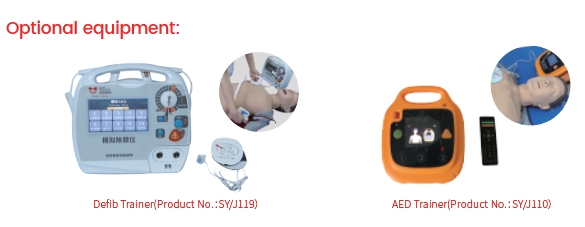
■ The simulated human is made of polymer materials, which are environmentally friendly and pollution-free; The anatomical landmarks are obvious and can touch the nipples, ribs, sternum, and xiphoid process, making it easy to operate and locate.
■ Simulate the accurate anatomical position of the human head and neck, with the head able to swing left and right and rotate horizontally 180 degrees, making it easy to remove oral foreign objects.
■ The eyeball adopts OLED simulation, with visible colored retina, black pupils, transparent crystals, and the ability to reflect light at any angle; In a dead state, the pupil dilates and the reflex to light disappears.
■ The carotid artery pulsation can be palpable, and in a state of death, the carotid artery pulsation disappears.

■ Cardiopulmonary resuscitation, execution standard: 2020 American Heart Association Cardiopulmonary Resuscitation and Cardiovascular Emergency Guidelines, supine position with head tilted back.
* Feasible chest compressions.
* There are three feasible methods to open the airway: lifting the chin, neck, and jaw with both hands.
* It is feasible to perform mouth to mouth artificial respiration or use a simple respirator to assist breathing, and effective artificial respiration can show chest undulations.
■ The latest bidirectional wave defibrillation technology can be used for real defibrillation.
■ endotracheal intubation
■ right hand for intravenous injection and blood collection
■ the left hand can be used for blood pressure measurement, free setting
of systolic pressure, diastolic pressure, pulse frequency and pulse
strength, or random setting. The blood pressure measurement has obvious
Coriolis sound, which is produced by pulse beat and broadcast through
non loudspeaker. The brachial artery and radial artery can be touched.
Automatically display the position of blood pressure measurement cuff,
real-time display the speed of mercury drop and the maximum speed of
mercury drop.
■ chest undulation can be seen, breath sound can be heard, and breath sound disappears in the state of death
■ cyanosis on lips and fingernail beds
■ auscultation of cardiopulmonary sounds
■ There is trauma in the lower limbs, hemostasis and bandaging can be carried out
■ There are two communication methods to choose between analog humans and computers: USB communication and wireless WIFI communication.
■ The first aid chain has multiple automatic reactions throughout the entire process, including tapping, assessing carotid artery awareness, opening the airway, gas entering the stomach, CPR, and other indicators.
■ Electronic monitoring of multiple indicators throughout the process:
* Pressing section: Monitor the number of presses (multiple or few), pressing position (correct or incorrect), pressing depth (too large or too small), pressing frequency (correct or incorrect), pressing rebound, and displaying the interruption time of pressing
* Pressing operation waveform display: Real time display of pressing operation waveform, which can determine pressing depth, pressing frequency, pressing rebound situation, pressing interruption time, pressing position, etc.
* Monitoring of Blowing Part: Blowing frequency (excessive or insufficient), tidal volume (excessive or insufficient), tidal time, and gas intake into the stomach.
* Blowing operation waveform display: Real time display of blowing operation waveform, through which the blowing volume, blowing cycle, and moisture time can be determined.
■ According to the operating standards of the 2020 American Heart Association Guidelines for Cardiopulmonary Resuscitation and Cardiovascular First Aid, cardiopulmonary resuscitation operations can be evaluated, and the operation meets the standards, simulating human resurrection; The operation did not meet the standards, resulting in simulated human death.
■ The transcript can be saved and printed, and can be connected to a universal printer for printing.
■ CPR simulation training, with three operating modes: practice, assessment, and actual combat. Each mode can set its own training time, CPR cycle times, etc.
■ Full course electrocardiogram display:
* Before rescue: An electrocardiogram showing imminent death, disappearance of respiratory chart, and blood pressure below 60mmHg.
* Rescue in progress: During the pressing operation, the pressing electrocardiogram is displayed with the same frequency as the pressing frequency, and the respiratory monitoring displays the tidal operation graph.
* After successful rescue: it shows sinus rhythm and breathing returns to normal.









